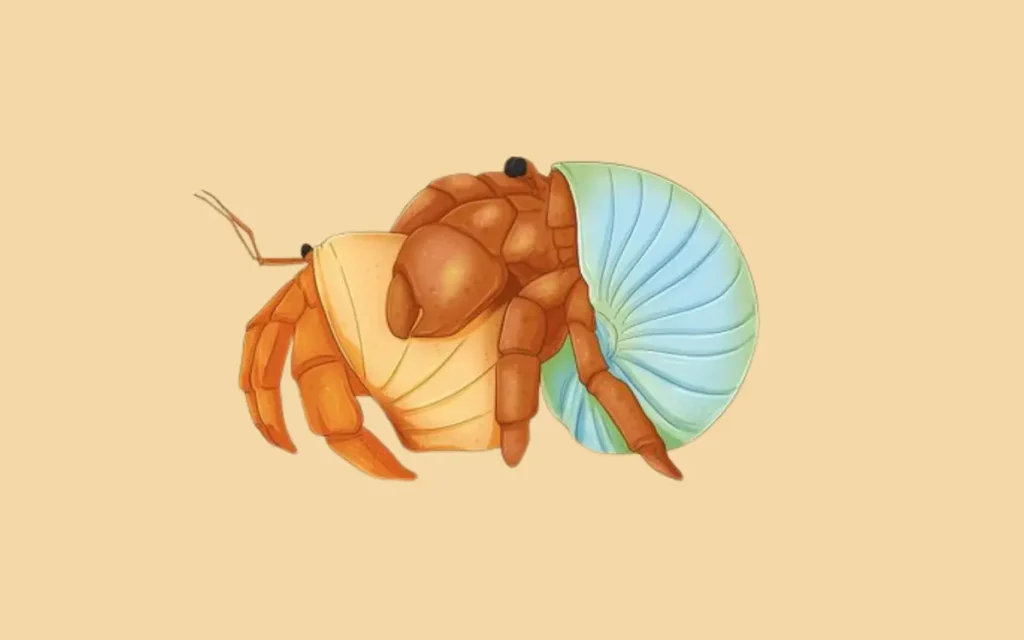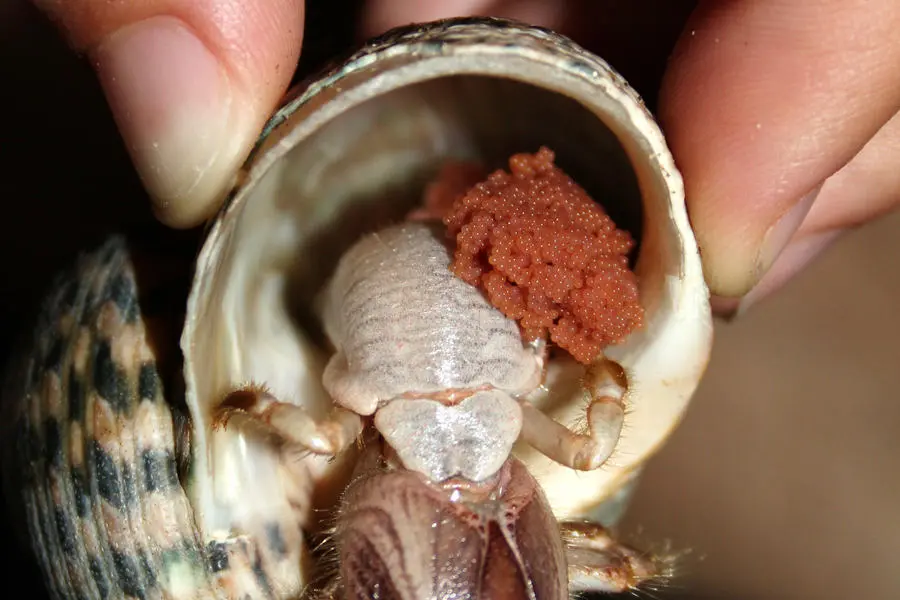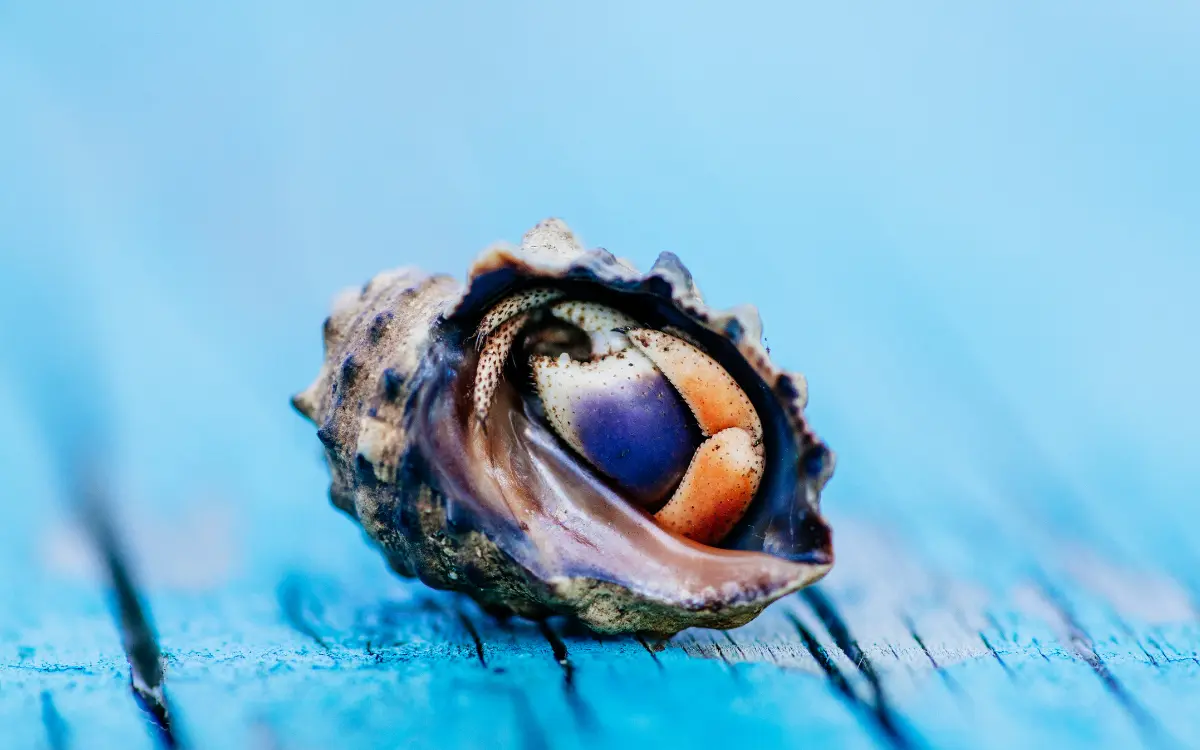Hermit crabs are fascinating creatures known for their unique behavior of living in borrowed shells. Unlike true crabs, hermit crabs have soft, vulnerable abdomens that they protect by occupying empty gastropod shells. This behavior is essential for their survival, as it offers protection from predators and environmental hazards.
Hermit crabs are found in both marine and terrestrial environments, showcasing a wide range of adaptations to different habitats. Their social nature, quirky movements, and intriguing behaviors make them popular pets and subjects of marine studies.
Overview of Their Reproductive Process

Hermit crabs have a distinct and interesting reproductive process that involves several stages:
Mating Behavior: Reproduction in hermit crabs begins with the mating process, typically occurring in the ocean for marine species and near water sources for terrestrial species. Male hermit crabs use their large claws to grasp the female during mating. This process can last from several minutes to hours.
Fertilization: The male deposits sperm into the female’s gonopores, which are located on the underside of her body. Fertilization is internal, and the female carries the fertilized eggs inside her shell.
Egg Development: After fertilization, the female hermit crab carries the eggs, which can number in the hundreds to thousands, under her abdomen. She keeps them attached to her pleopods, specialized appendages that help in aerating and cleaning the eggs.
Hatching: When the eggs are ready to hatch, the female releases them into the water. The timing is often synchronized with the tides to increase the larvae’s chances of survival.
Larval Stages: Hermit crab larvae, called zoea, undergo several developmental stages in the planktonic form. They drift in the water column, feeding on microscopic plankton and undergoing multiple molts as they grow.
Settlement: After completing the larval stages, the young hermit crabs, known as megalopa, settle to the bottom and begin searching for their first shells. This transition from a free-swimming larva to a shell-dwelling juvenile is a critical phase in their life cycle.
Sexual Reproduction
Explanation of Sexual Reproduction in Hermit Crabs
Hermit crabs reproduce sexually, which involves the combination of genetic material from two individuals, a male and a female, resulting in offspring that are genetically diverse. This process begins with the mating behavior, followed by fertilization, and culminates in the development of larvae.
Description of How Hermit Crabs Mate
Mating Process:
- Finding a Mate: During the breeding season, which varies depending on the species and environment, male and female hermit crabs seek each other out. This often involves the male initiating contact by approaching the female.
- Courtship: The male hermit crab uses his larger claw to tap and stroke the female, signaling his intent to mate. This courtship behavior can be quite elaborate and may last for some time until the female is receptive.
- Grasping: Once the female is receptive, the male uses his claws to grasp the female securely. This physical contact is necessary to ensure the successful transfer of sperm.
Transfer of Sperm:
- Alignment: The male aligns his body with the female’s to bring their reproductive openings into close proximity. The male’s reproductive organs, called pleopods, are equipped with specialized structures to facilitate the transfer of sperm.
- Sperm Transfer: The male deposits sperm into the female’s gonopores, which are small openings located on the underside of her body near the base of her last pair of walking legs. This process can take several minutes to hours, depending on the species and environmental conditions.
- Internal Fertilization: After the transfer, the female stores the sperm in her body until she is ready to fertilize her eggs. Internal fertilization ensures that the eggs are protected from external factors and can develop safely within the female’s body.
Mating Rituals

Details of the Mating Behavior of Hermit Crabs
Hermit crab mating rituals are complex and involve several behaviors to ensure successful reproduction. During the breeding season, male hermit crabs actively seek out females by using chemical cues and pheromones.
- Courtship Displays: The male initiates courtship by tapping and stroking the female with his larger claw. This behavior helps in gaining the female’s attention and consent for mating.
- Physical Grasping: If the female is receptive, the male will use his claws to firmly grasp her shell. This hold ensures that the female remains still during the mating process, allowing for the precise transfer of sperm.
- Positioning: The male aligns his body with the female’s to bring their reproductive organs into close contact. This careful positioning is crucial for the transfer of sperm to be effective.
The Role of the Environment in Their Mating Rituals
- Proximity to Water: Hermit crabs, especially marine species, require proximity to the ocean for successful mating and subsequent egg development. Terrestrial hermit crabs also need access to water sources for similar reasons.
- Tidal Influence: Many species time their mating and egg release with tidal cycles to maximize the chances of larval survival. High tides help disperse the larvae into the ocean, where they can begin their planktonic stage.
Egg Development and Care

How Female Hermit Crabs Carry and Care for Their Eggs
- Carrying Eggs: After fertilization, the female hermit crab carries the fertilized eggs under her abdomen. The eggs are attached to her pleopods, which are specialized appendages that help in holding and aerating the eggs.
- Aeration and Cleaning: The female regularly moves her pleopods to aerate the eggs, ensuring they receive enough oxygen. She also cleans the eggs by brushing them with her appendages to prevent fungal or bacterial infections.
Changes in the Eggs’ Appearance as They Mature
- Initial Stage: Initially, the eggs are small, round, and often a pale color. They are tightly packed under the female’s abdomen.
- Mid Development: As the eggs develop, they increase in size and start to change color, often becoming darker. This change is due to the developing embryos inside.
- Pre-Hatching: Just before hatching, the eggs become almost transparent, and the tiny larvae inside can be seen moving. The color may shift to a more vibrant hue, indicating they are ready to be released.
Read also:- Hermit Crab Molting Signs: How to Recognize
Release and Hatching of Eggs
Process by Which Female Hermit Crabs Release Eggs into the Ocean
- Timing with Tides: Female hermit crabs often synchronize the release of their eggs with the tides. This timing maximizes the dispersal and survival chances of the larvae.
- Releasing Eggs: When the eggs are ready to hatch, the female moves to a location where the ocean’s tide can carry them away. For marine species, this is typically in shallow waters; for terrestrial species, it’s near water sources.
- Egg Release: The female releases the eggs by rapidly moving her pleopods. The eggs are then carried by the water currents into the ocean, where they begin their planktonic journey.
Description of the Hatching Process and the Initial Larval Stage Known as Zoeae
- Hatching: As the eggs are released into the water, they hatch almost immediately, releasing tiny larvae known as zoeae.
- Zoeae Stage: The zoeae are microscopic, planktonic larvae with elongated bodies and feathery appendages. They are highly mobile and begin feeding on microscopic plankton available in the water.
Development of Zoeae
Stages of Development from Zoeae to Megalopae
- Zoeae Stages: Zoeae undergo several molts, each stage called an instar, during which they grow and develop. These stages can last from a few weeks to several months, depending on environmental conditions.
- Transformation to Megalopae: After several instars, the zoeae undergo a significant transformation into a stage called megalopa. This stage is characterized by a more developed body resembling a small adult hermit crab but still lacking a shell.
Transition from Aquatic to Terrestrial Life as They Find Their First Shells
- Settling: The megalopa stage is a transitional phase where the larvae settle to the ocean floor or the shoreline. They begin to seek out and compete for small shells, which are crucial for their protection and continued development.
- Shell Selection: Finding a suitable shell is critical. The megalopa must find a shell that fits its body well enough to provide protection but also allows room for growth. This process can be highly competitive, especially in areas with limited shell availability.
- Transition to Land: For terrestrial species, once they have found their first shells, they begin the journey towards more terrestrial habitats. This transition involves moving from the aquatic environment to the land, where they will continue to grow and mature into adult hermit crabs.
Challenges in Captivity
Discussion on the Difficulties of Breeding Hermit Crabs in Captivity
Breeding hermit crabs in captivity poses several significant challenges. These challenges stem from their complex reproductive behaviors, specific environmental requirements, and the delicate nature of their larval stages.
- Complex Mating Behavior: Hermit crabs have intricate mating rituals that are difficult to replicate in captivity. Captive environments often lack the stimuli that trigger natural mating behaviors.
- Environmental Conditions: Replicating the precise conditions needed for successful breeding, such as specific temperature, humidity, and tidal influences, is challenging in an artificial setting.
- Larval Care: Hermit crab larvae (zoeae) require specific water conditions, including salinity and plankton availability, which are hard to maintain consistently in captivity. The larvae are also highly sensitive to changes in water quality and require meticulous care.
- Shell Availability: Ensuring a constant supply of appropriately sized shells for the growing hermit crabs is crucial. In captivity, a lack of suitable shells can lead to stress and aggressive behavior among the crabs.
Necessary Conditions for Successful Breeding in Artificial Settings
- Simulating Natural Habitats: Creating an environment that closely mimics the natural habitat of hermit crabs is essential. This includes maintaining appropriate water conditions, temperature, and humidity levels.
- Providing a Varied Diet: Hermit crabs need a varied diet that includes both plant and animal matter. A diet rich in calcium is particularly important for egg development and larval health.
- Water Quality Management: Ensuring optimal water quality is critical for the survival of zoeae. Regular monitoring and maintenance of water parameters like pH, salinity, and temperature are necessary.
- Shell Supply: Providing a plentiful and diverse supply of shells of various sizes is crucial for the development of hermit crabs at different life stages. This helps reduce stress and competition among crabs.
- Controlled Light Cycles: Mimicking natural light cycles can help regulate the crabs’ biological rhythms and improve breeding success.
Conservation and Impact
The Importance of Understanding Hermit Crab Reproduction for Conservation Efforts
- Population Management: Understanding the reproductive processes of hermit crabs is vital for managing and maintaining healthy populations, both in the wild and in captivity.
- Biodiversity Preservation: By ensuring the survival and reproduction of hermit crabs, we contribute to the overall health and biodiversity of marine and coastal ecosystems, where they play a crucial ecological role.
- Breeding Programs: Knowledge of hermit crab reproduction can aid in developing successful breeding programs, which are essential for species conservation, especially for those at risk due to habitat loss and environmental changes.
Impact of Environmental Changes on Their Reproductive Processes
- Climate Change: Rising ocean temperatures and changing salinity levels can disrupt the breeding cycles of hermit crabs, affecting their ability to reproduce successfully.
- Pollution: Water pollution, including plastic waste and chemical contaminants, can adversely affect the health and reproductive success of hermit crabs, particularly at the larval stage.
- Habitat Destruction: Coastal development and habitat destruction can lead to the loss of critical breeding grounds for hermit crabs, reducing their populations and genetic diversity.
- Shell Availability: The depletion of natural shell resources due to human activities can limit the availability of suitable shells for hermit crabs, impacting their growth and survival rates.
Read also: Male vs Female Crab – How do you differentiate?
Conclusion
Summary of the Key Points About Hermit Crab Reproduction
Hermit crab reproduction is a complex and fascinating process involving several stages, from mating rituals to the development of larvae. Key points include:
- Mating Rituals: Hermit crabs engage in intricate mating behaviors, with males using courtship displays and physical grasping to transfer sperm to females. The process is heavily influenced by environmental factors, particularly proximity to water sources.
- Egg Development and Care: Female hermit crabs carry fertilized eggs under their abdomens, providing aeration and cleaning until the eggs are ready to hatch. The eggs undergo significant changes as they mature, becoming darker and more developed.
- Release and Hatching of Eggs: Females release the eggs into the ocean, often synchronized with tidal cycles. The eggs hatch into planktonic larvae known as zoeae, which then undergo several developmental stages before settling and finding their first shells.
- Challenges in Captivity: Breeding hermit crabs in captivity presents numerous difficulties, including replicating natural environmental conditions and ensuring the survival of delicate larvae. Specific conditions, such as water quality and shell availability, are critical for successful breeding.
- Conservation and Impact: Understanding hermit crab reproduction is essential for conservation efforts. Environmental changes, such as climate change, pollution, and habitat destruction, significantly impact their reproductive success and overall survival.
Final Thoughts
Protecting hermit crabs and their habitats is vital for maintaining the health and biodiversity of marine and coastal ecosystems. These creatures play crucial ecological roles, and their unique reproductive processes highlight the intricate balance of nature.
By ensuring the conservation of hermit crabs, we contribute to the preservation of our natural world and the intricate web of life it supports. Efforts to understand and protect hermit crabs can lead to better management practices, successful breeding programs, and a more sustainable future for these fascinating creatures.

